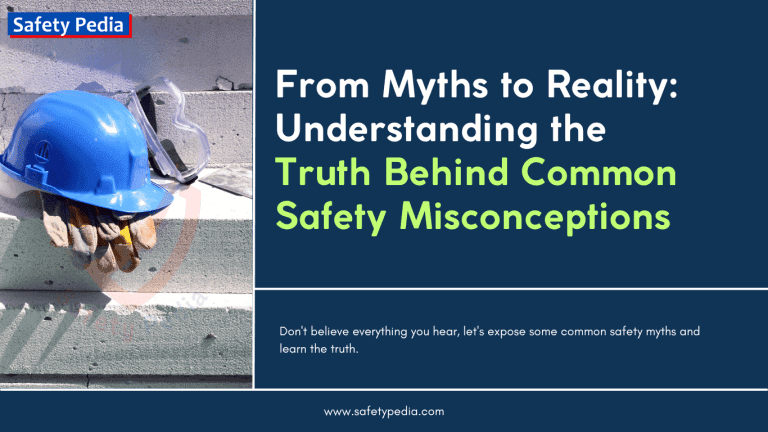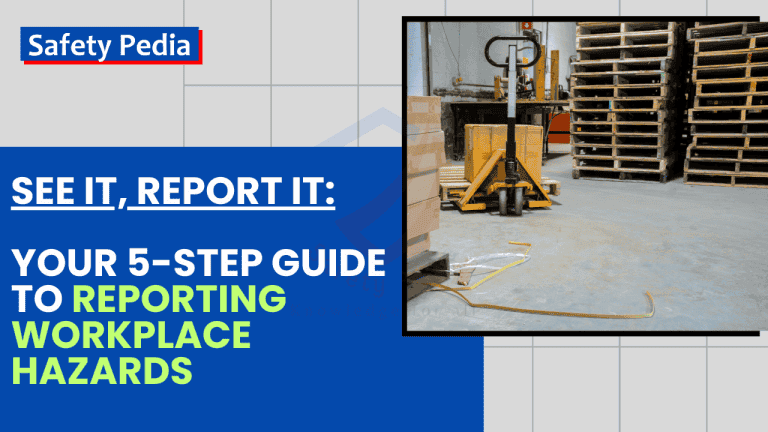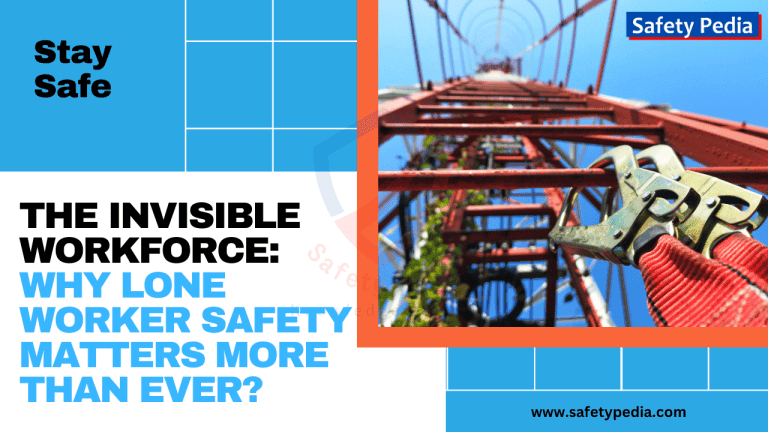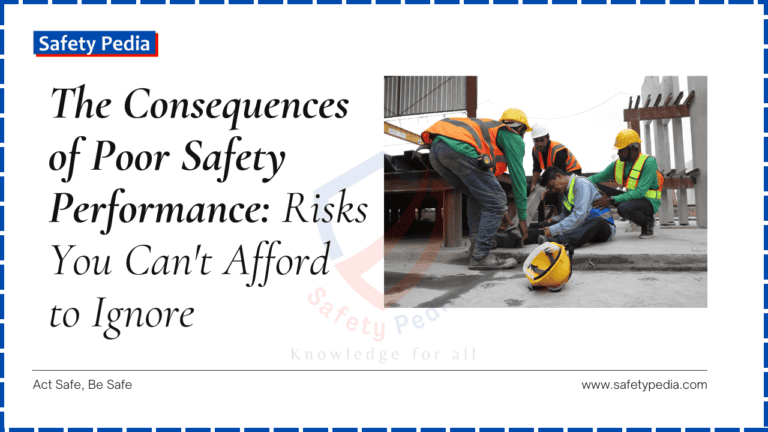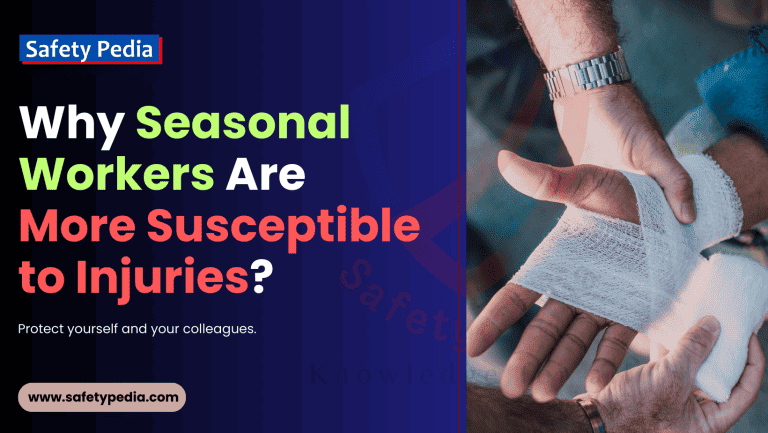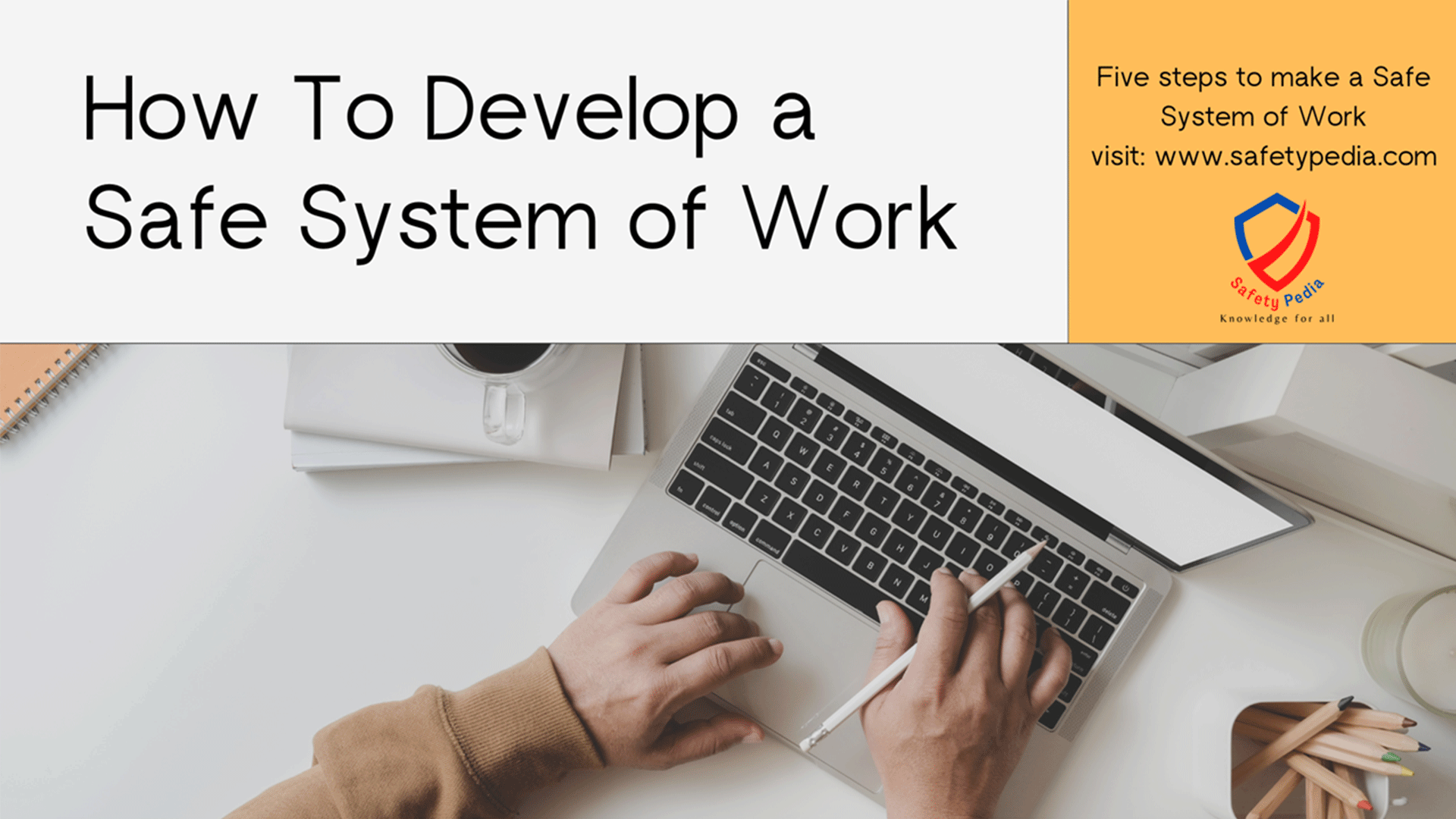
Introduction:
In any workplace, safety should be the top priority. To ensure the well-being of employees and prevent accidents, organizations need to establish a robust, Safe System of Work (SSoW). This system involves a structured approach that considers various factors, sources of information, and actions necessary to mitigate risks and provide a secure environment for employees. In this blog post, we’ll delve into the key elements of a safe system of work, sources of information for its development, enforcement actions, and a practical example.
A safe work system is a formal procedure developed to execute a job safely. It is developed when the engineering controls or the design features are insufficient to eliminate or reduce the risk to an acceptable level. Many accidents occur each year where the non-availability of safe working methods was stated as a root cause. However, a careful study is required while developing SSoW for accident prevention. This article enables you to learn How to develop a safe system of work.
Organizations may develop a standard operating procedure (SOP) to ensure the consistent development of SSoW. Employers should arrange a specific training session on “How to develop a Safe System of Work” to increase the competence of their personnel. Remember, it is not an easy job that can’t be done alone. Therefore, involve the worker performing the activity, the supervisor, the process owner, the technical team, and the safety professionals in developing a safe system of work.
How to Develop a Safe System of Work?
Commonly, a 5 steps approach is adopted to develop safe working methods by eliminating all hazards or minimizing risks as stated below:
- Assess the task or job to be performed
- Identify hazards & evaluate risk
- Develop safe working methods
- Implement a safe system of work
- Monitor the safe system of work
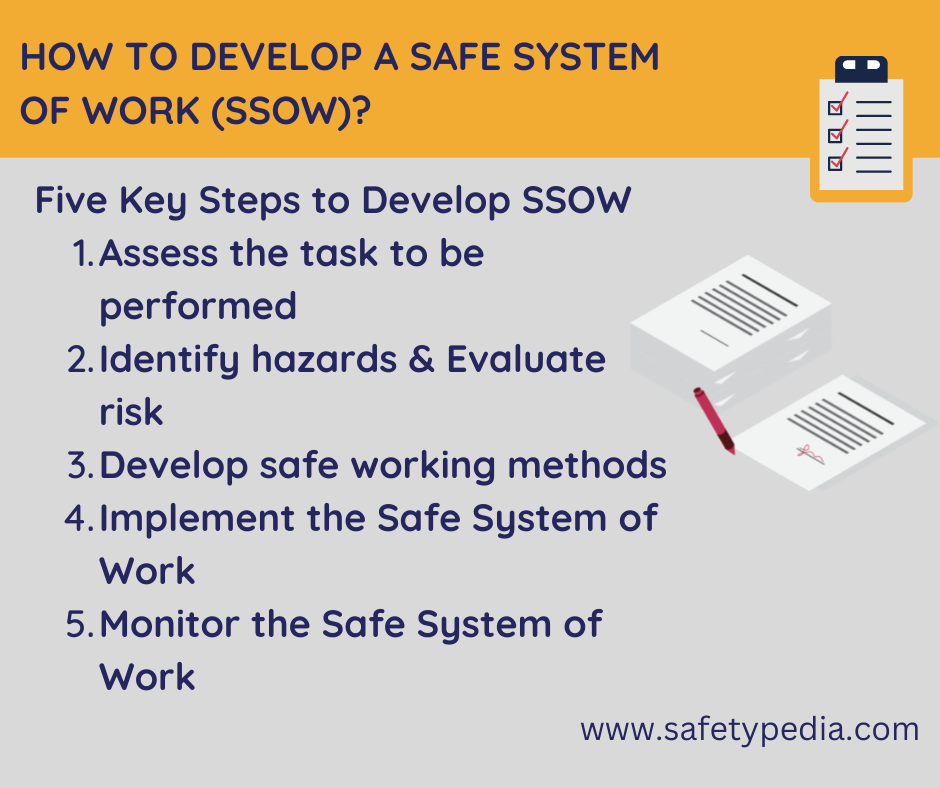
Step # 1: Assess the Task or Job to Be Performed
One of the key steps in developing a safe system of work is to conduct a job or task analysis. This is a systematic process of identifying and examining the components of a job or task. There are two main types of job or task analysis: job-based and task-based.
- A job-based analysis focuses on the overall role and responsibilities of a worker, such as a machine operator or a forklift truck driver.
- A task-based analysis focuses on a specific activity or operation within a job, such as painting, manual handling, or housekeeping.
Task or job analysis is breaking down the steps involved in performing a job. When developing safe systems of work detailed assessment of the task or job is necessary. Consider the material or equipment requirements to carry out the task, as these may have their own hazards. Consider the people involved in performing the task, such as their experience, the number of persons, and the presence of vulnerable groups. Initially, recording all the steps required to perform the task is recommended to ensure nothing important is missed. The list may get long, but it is essential to assess the task well.
The steps involved in a job or task analysis are:
- Selection of Job/Task: Determining which job or task will be analyzed. This can be based on various criteria, such as frequency, severity, complexity, or novelty of the job or task, or the feedback from workers, supervisors, managers, or customers.
- Breakdown into Steps: Breaking down the job or task into a sequence of smaller sub-steps or activities. This can be done by observing the workers performing the job or task, interviewing them, reviewing documents such as manuals, procedures, checklists, or incident reports, or using flowcharts, diagrams, or photographs.
- Identifying Hazards & Current Controls: Identifying potential hazards and current control measures against each step. A hazard is anything that can cause harm to people, property, or the environment. A control measure is anything that can prevent or reduce the likelihood or severity of harm. Hazards and control measures can be classified into three categories: engineering (such as guards, alarms, and ventilation), administrative (such as training, supervision, and policies), and personal protective equipment (such as gloves, goggles, and helmets).
- Effectiveness of the current control measures: Consider the effectiveness of the current control measures. This can be done by evaluating whether the control measures are suitable, adequate, reliable, accessible, and used correctly by the workers. The hierarchy of control should be followed when selecting control measures, which means giving priority to eliminating the hazard, substituting it with something less hazardous, then isolating it from people, applying engineering controls, applying administrative controls, and finally using personal protective equipment.
- Assessing the need for further control measures: This can be done by identifying the gaps or weaknesses in the current control measures and proposing new or improved control measures to address them. The proposed control measures should be realistic, feasible, cost-effective, and acceptable to the workers and management.
The task analysis allows the assessor to point out the hazards in an organized way. Each of the recorded steps may have its associated hazards. Therefore, safe working methods should be developed to reduce the risk. The organizations may develop a standard format to assess the task and systematically record all the required information.
Considerations in Analysis for Safe System of Work Development:
- Nature of Work: Understanding the specific characteristics and requirements of the task or job. This includes the purpose, scope, objectives, and expected outcomes of the work.
- Work Environment: Identifying where the work is being performed. This includes the location, layout, environment, and accessibility of the work area. (e.g., indoors, outdoors, confined spaces).
- Equipment, Materials, and People Involved: Assessing the tools, materials, and personnel required for the job/task. This includes the type, condition, availability, suitability, compatibility, and quantity of the equipment and materials used for the work, as well as the number, qualification, experience, competence, and attitude of the workers involved in the work.
- Evaluation of Current Controls: Reviewing the effectiveness of existing safety measures and controls. This includes the existing engineering, administrative, and personal protective equipment controls that are applied to prevent or minimise harm from the work.
- Adequacy of Current Controls: Determining whether the current controls are sufficient to mitigate risks. This includes assessing whether the current controls are effective in eliminating or reducing the hazards and risks associated with the work.
- Correct Use by Workers: Ensuring that employees understand and correctly utilize the provided controls and safety measures. This includes ensuring that the workers are aware of, understand, and comply with the controls that are in place for their safety.
- Behavioral Factors: Considering human factors such as errors, violations, and the role of workers, supervisors, and managers in maintaining safety protocols. This includes considering how human factors such as errors and violations can affect the safety performance of the work.
By systematically analyzing these elements, organizations can create a comprehensive understanding of the risks associated with a particular job or task.
Step # 2: Identify Hazards & Evaluate Risk
The second step is to identify the hazards and evaluate the risks associated with each part of the work process. A hazard is anything that can cause harm, such as a chemical, a machine, a tool, or a human error. A risk is the likelihood and severity of harm occurring from exposure to a hazard. By identifying the hazards and evaluating the risks, we can determine what level of control is needed to prevent or reduce the harm.
Each step recorded earlier may have associated risks involved. Careful assessment against each step to identify hazards is necessary. Assess the risk based on the probability of a bad event’s occurrence and consequences. You may ask questions such as how the work is being carried out, what hazards are involved, and what difficulties might arise while performing the activity and putting workers at risk. During the risk evaluation, you may remove irrelevant or unnecessary steps to prevent the long length of the document. This process is similar to “Harazd Identification and Risk Assessment”.
There are various methods and tools for identifying hazards and evaluating risks, such as task analysis, checklists, inspections, audits, incident reports, hazard registers, risk matrices, etc. The method and tool used should be appropriate for the type and complexity of the work activity and should involve consultation with the workers and other stakeholders who are familiar with the work process.
The identification of hazards and evaluation of risks is an important stage of developing safe systems of work. It helps to identify the gaps and weaknesses in the current system of work and to propose improvements that will enhance safety and efficiency. It also helps to ensure that the system of work is aligned with the objectives and requirements of the work activity.
- Identify hazards: Once the job or task has been analyzed, the next step is to identify the hazards associated with the task. This can be done by brainstorming, using checklists, or conducting a risk assessment.
- Evaluate risk: Once the hazards have been identified, the next step is to evaluate the risk of each hazard. This can be done by considering the likelihood of the hazard occurring and the severity of the potential harm.
- Develop controls: Based on the evaluation of risk, appropriate controls can be developed and implemented to eliminate or reduce the risk of harm.
However, this stage is not a one-off exercise. It should be repeated periodically or whenever there is a change in the work process, equipment, environment, personnel, etc. This will help to monitor and review the effectiveness of the controls implemented, and to identify any new or emerging hazards or risks that may arise.
Step # 3: Develop Safe Working Methods
One of the key steps in creating a safe system of work is to develop safe working methods. This means that you need to identify the best ways to perform the tasks that are required for a job or task and to ensure that they are done in a way that minimizes the risks to your health and safety.
The key idea is to develop methods to eliminate or reduce the overall risk while performing the task. Create a strategy that outlines the steps that will be taken to eliminate or control identified hazards, including procedures, policies, and training.
- Defining Safe and Healthy Working Methods: This step requires establishing clear and precise protocols that are the safest and healthiest approach to performing tasks. It involves detailing the step-by-step procedures to follow while considering the identified hazards and risks.
- Formulating Procedures: Creating comprehensive procedures is crucial. These procedures should encompass the identified hazards, the necessary control measures, safe operating practices, emergency protocols, and any specific steps required for a particular task or job. Clear communication and understanding of these procedures by all involved parties are essential.
The task performer must be included in the team while developing safe working methods to ensure viability. They may raise concerns at the preparation stage and ultimately take ownership of new procedures. Get these safe working methods approved for implementation with mutual consensus. Provide a copy to all concerns and schedule a meeting before implementation.
Developing safe working methods is not a one-time activity. You need to review and update them regularly, especially when there are changes in the work environment, equipment, materials, or personnel. You also need to monitor and evaluate the effectiveness of the safe working methods and make improvements as needed.
Step # 4: Implement a Safe System of Work
The fourth step in developing a safe system of work is to implement it. This means putting into practice the procedures, controls, and measures that have been identified to eliminate or reduce the risks associated with the work activity. Here are some tips on how to implement a safe system of work effectively:
- Get formal acceptance: Before implementing a safe system of work, you need to get the formal acceptance of the people who will be involved in it, such as managers, workers, contractors, clients, or any stakeholder. This can be done by getting them to sign a written document that outlines the system. Formal acceptance helps to ensure that everyone understands their roles and responsibilities and that they are committed to the system.
- Rolling Out Safe Procedures: This phase involves putting the designed safe working methods and procedures into action across the workplace. It includes disseminating the established protocols, guidelines, and controls to all relevant personnel.
- Provide instruction and training: Once you have the formal acceptance, you need to provide instruction and training to the people who will be using the system. This training should cover the purpose and benefits of the system, demonstrate how to perform the tasks safely, and introduce newly defined safe working methods, procedures, controls, and any specific protocols related to their roles. Instruction and training help to ensure that everyone has the skills and knowledge to follow the system correctly and consistently.
- Evaluate the system. After implementation, there should be a period allocated to assess the effectiveness of the system. This can be done by monitoring and measuring the performance of the system, such as by observing the work activities, collecting data on incidents and near misses, conducting audits and inspections, and soliciting feedback from workers and other stakeholders. Evaluation helps to identify any problems or gaps in the system and to assess whether the system is achieving its objectives.
- Modify the system if needed. If you find any problems or gaps in the system during the evaluation, you need to modify the system accordingly by making formal changes to the procedures and documentation. This can include revising the procedures or practices, providing additional instruction or training, changing the equipment or materials, or introducing new controls or safeguards. Modification helps to improve the system and to prevent or reduce the recurrence of incidents or injuries.
Implement the plan by implementing the necessary procedures, policies, and training programs. Integrate a permit-to-work system to implement the safe work system. The implementation can be challenging, especially in a low-safety culture organization. Therefore, providing training on the newly developed method is vital. Engaging workers in the process is recommended as they feel honored and responsible.
Implementing a safe system of work is an important step in ensuring a safe and healthy workplace. By following these tips, you can implement a safe system of work effectively and efficiently.
Step # 5: Monitor the Safe System of Work
The fifth step in developing a safe system of work is to monitor the system. Humans are not robots; they make errors and, therefore, frequently supervise the implementation of SSOW. Monitor the implemented safe work system to confirm its effectiveness in reducing risk levels. If not, review again, observe the gaps, and take corrective actions as a part of continual improvement. Regular monitoring and reviewing can improve the effectiveness of the SSOW. Continuously review the system and make improvements as necessary, considering new hazards or incidents that may arise.
- Reviewing the compliance and effectiveness of the SSW through formal methods, such as direct observation, inspections, audits, or surveys
- Utilizing technological tools such as artificial intelligence for tracking and reporting compliance can help improve the monitoring mechanism
- It’s essential to have a formal monitoring process in place. Keeping detailed records of compliance and effectiveness helps track the implementation of safe working methods. This documentation can serve as evidence of adherence to safety protocols and identify areas needing improvement.
- Reviewing the feedback and suggestions from the workers and managers who are involved in the SSW, through informal methods, such as team meetings, safety committee meetings, or suggestion boxes. Employees should be actively engaged in the monitoring process.
- Reviewing the outcomes and impacts of the SSW, such as accident rates, injury severity, near misses, or worker satisfaction.
- Reviewing the changes and updates in the work environment, such as new equipment, processes, regulations, or standards.
- Conducting periodic audits and reviews of the SSW is essential. These assessments help ensure compliance, identify any deviations, and ascertain the need for modifications or updates to the system.
Monitoring the SSOW is not a one-time activity. It should be done periodically and systematically, according to a predefined schedule or criteria. The frequency and scope of monitoring may vary depending on the nature and complexity of the work activity, the level of risk involved, and the performance of the SSW.
The benefits of monitoring the SSOW are:
- It helps to identify any gaps, weaknesses, or non-compliance issues in the SSW, and to take corrective actions accordingly.
- It helps to evaluate the effectiveness and efficiency of the SSOW and to measure its impact on safety performance and worker well-being.
- It helps to involve and engage the workers and managers in the SSW process, and to foster a culture of continuous improvement and learning.
- It helps to ensure that the SSW is up-to-date and relevant to the current work conditions and requirements.
Monitoring the SSW is a key component of ensuring safety in the workplace. By following these steps and tips, you can monitor your SSW effectively and make sure it is delivering its intended results. This ongoing process contributes significantly to maintaining a safe and healthy work environment.
Example: Safe System of Work (SSOW) for High-Rise Building Glass Window Cleaning

Disclaimer: This example of Safe System of Work is provided for educational and illustrative purposes only. It does not constitute professional safety advice and should not be relied upon as such. The information contained herein is of a general nature and may not be suitable for all situations. Creating a safe system of work for any specific task requires a comprehensive risk assessment conducted by competent professionals at the actual work site.
This includes identifying all potential hazards, evaluating the risks associated with those hazards, and implementing appropriate control measures in accordance with applicable regulations and the organization’s specific risk matrix.
Therefore, no warranty or guarantee, express or implied, is made regarding the completeness, accuracy, reliability, suitability, or availability with respect to the information, products, services, or related graphics contained within this document for any purpose. Any reliance you place on such information is therefore strictly at your own risk. In no event will we be liable for any loss or damage including without limitation, indirect or consequential loss or damage, or any loss or damage whatsoever arising from loss of data or profits arising out of, or in connection with, the use of this information.
What are the important features of a good SSOW?
The Safe System of Work is a document that defines the rights and responsibilities of all employees in the workplace. It covers such topics as:
- What are the legal rights of an employee?
- How long should an employee work before they are entitled to a break?
- Who should be responsible for health and safety?
- Which employees have access to what information?
- What is the appropriate way to discipline an employee?
- How does the SSOW help protect your company from legal risks?
A safe system of work or method statement is a legal requirement of the Health and Safety at Work Act 1974. It is an employer’s responsibility to ensure safe work systems are implemented. Ensure that the safe system of work complies with relevant laws, regulations, and industry standards.
Develop a communication plan that will help inform and educate employees about hazards, risks, and the steps to mitigate them. “Safe Systems of Work can reduce or eliminate exposure to hazards, but these must be strictly followed.”
Factors to Consider When Developing a Safe System of Work
When creating a safe system of work, several factors need to be carefully considered:
Purpose of the Activity: What is the objective of the work? What are the expected outcomes? How will the work benefit the organization or the client? Clearly define the purpose of the task, outlining its objectives and intended outcomes.
Task and Subtasks Involved: What steps are involved in completing the work? How long will each step take? What are the dependencies and sequences of the steps? Break down the task into smaller subtasks to better understand the sequence of actions required.
Hazards and Risk Assessment: What are the potential sources of harm or damage that could arise from the work? How likely are they to occur? How severe could they be? What are the consequences for people, property, environment, and reputation? What information is needed to plan, execute, and evaluate the work activity? Where can it be obtained from? How will it be communicated and recorded? Identify potential hazards associated with each task and subtask and evaluate the associated risks.
People Involved in the Activity: Who will perform the work? How many people are needed? What are their roles and responsibilities? What are their qualifications, skills, and competencies? Do they need any training or supervision? Determine the number of people required for the task, along with their competency.
Equipment and Materials: What are the tools, machines, vehicles, substances, or other resources that will be used for the work? Are they suitable, adequate, and in good condition? Do they meet any standards or specifications? Do they require any maintenance or inspection? List the necessary equipment and materials, ensuring they are in good condition and appropriate for the task.
Safe Work Methods: How will the work be carried out? What are the procedures, instructions, or guidelines that will be followed? Are they clear, consistent, and up to date? Do they comply with any regulations or best practices? What measures will be taken to eliminate or reduce the risks associated with the work activity? How will they be implemented and monitored? Who will be responsible for them? Develop safe and effective methods for completing each subtask.
Working Environment: Where will the work take place? What are the physical, social, and psychological conditions of the workplace? Are there any hazards or challenges that could affect work performance or safety? Evaluate the working environment for potential hazards and adapt the plan accordingly.
Legal Requirements: What are the laws, regulations, codes, or standards that apply to the work activity? Are they relevant, current, and accessible? How will they be complied with and documented? Ensure compliance with relevant laws and regulations related to safety and occupational health.
Emergency Procedures: What actions will be taken in case of an emergency or an incident during the work activity? Who will be involved and notified? How will they be prepared and trained? Develop clear emergency procedures for different scenarios that might arise during the task.
Monitoring Systems: How will the performance and safety of the work activity be measured and reviewed? What indicators or criteria will be used? How often and by whom? Establish a system for ongoing monitoring and review of the safe system of work.
Sources of Information for Developing a Safe System of Work
When developing a safe system of work, it’s essential to consult various sources to ensure accuracy and comprehensiveness. Here are some sources to consider:
- Manufacturer’s Recommendations: Manufacturers often provide guidelines for safe equipment use and maintenance. These are instructions or advice provided by the manufacturers or suppliers of equipment or materials used for the work activity. They may include specifications, manuals, labels, warnings, or datasheets.
- Industrial Research: Stay updated on industry best practices and research findings related to safety. This is information obtained from scientific studies or experiments conducted by industry associations, academic institutions, or other organizations. It may include reports, publications, journals, or databases.
- Legislation: Understand relevant laws and regulations that pertain to the specific task and workplace. This is information derived from laws or statutes enacted by governments or authorities. It may include acts, regulations, orders, rules, or codes.
- Approved Codes of Practices: These official guides provide practical advice on complying with safety regulations. These are documents that provide practical guidance on how to comply with legislation or standards. They may be issued by regulators, industry bodies, or professional associations.
- International Standards: Consult international safety standards applicable to your industry. These are documents that specify requirements or criteria for products, services, processes, or systems. They may be developed by international organizations such as ISO (International Organization for Standardization) 45001 occupational safety and health management systems or IEC (International Electrotechnical Commission).
- Accident Records: Analyzing past accident records can highlight recurring issues and inform safety measures. These are records of incidents or injuries that have occurred in similar or related work activities. They may include reports, investigations, analyses, statistics, or lessons learned.
- Risk Assessments: These are systematic processes of identifying hazards and evaluating risks associated with a work activity. They may include methods such as checklists, matrices, diagrams, or software tools. Conduct thorough risk assessments to identify potential hazards and their severity.
- Feedback from the Workforce: Gather input from employees who perform the tasks; they often have valuable insights. This is information collected from workers who are involved in or affected by the work activity. It may include opinions, suggestions, complaints, observations, or experiences.
Necessary Information a comprehensive SSOW may have
Below is the information that should typically be included in a comprehensive SSOW:
- Title and Description of Task: A clear and concise explanation of the activity or process.
- Location: Specify where the task will take place.
- Responsible Person(s): Identify supervisors, managers, or competent persons overseeing the task.
- Hazard Identification: List potential hazards associated with the task (e.g., machinery, chemicals, working at heights).
- Risk Assessment: Provide a summary of the risk assessment, including the likelihood and severity of identified risks.
- Control Measures: Outline controls in place to mitigate the risks (e.g., engineering controls, administrative controls, PPE).
- Step-by-Step Instructions: Detail the sequential steps to perform the task safely.
- Precautions to Take: Highlight specific actions to reduce risk (e.g., isolation procedures, restricted access).
- Permits to Work (if applicable): Mention any permits required, such as hot work or confined space permits.
- List of Equipment: Include all tools, machines, or devices necessary for the task.
- Pre-Use Checks: Detail any inspection or maintenance checks required before use.
- Safe Operating Instructions: Provide guidance on the proper and safe use of equipment.
- Roles and Responsibilities: Define roles of all personnel involved.
- Required PPE: List all PPE necessary for the task (e.g., gloves, helmets, goggles).
- PPE Usage Guidelines: Include instructions on how to properly use and maintain the PPE.
- Emergency Contacts: Provide phone numbers for emergency services, supervisors, or first aiders.
- Response Plans: Detail steps to take in the event of an incident (e.g., evacuation, spill containment, first aid).
- Location of Emergency Equipment: Specify locations of first aid kits, fire extinguishers, or eye wash stations.
- Briefings: Mention pre-task briefings or toolbox talks to ensure all workers are informed.
- Signage and Labels: Indicate the use of warning signs or labels where necessary.
- Coordination with Third Parties: Address communication protocols with contractors or external personnel.
- Supervision: Detail how the task will be monitored to ensure compliance with the SSOW.
- Audits and Inspections: Specify any planned audits or safety checks during the task.
- Review and Update: Include procedures for periodic review or updates to the SSOW to reflect changes in processes, equipment, or regulations.
- Signatures: Include signatures of the responsible manager and workers to confirm understanding and compliance.
- Version Control: Record the document’s version, date, and any updates.
- Supporting Documents: Reference related documents such as risk assessments, COSHH sheets, or permits to work.
Enforcement Actions for Organizations with Inadequate Safe Systems of Work
Enforcement officers play a critical role in ensuring workplace safety. An enforcement officer is a person who has the authority to inspect, investigate, or enforce compliance with health and safety legislation. They may work for government agencies, such as OSHA (Occupational Safety and Health Administration) in the US, or HSE (Health and Safety Executive) in the UK, or for private organizations, such as insurance companies or trade unions. When an organization has failed to provide a “safe system of work”, an enforcement officer could take the following actions:
- Issue a verbal or written warning: This notice informs the organization of the violation and requires them to correct it within a specified time frame.
- Issuing Notices: Enforcement officers can issue improvement or prohibition notices, requiring the organization to rectify safety shortcomings. This is a legal document that orders the organization to make specific improvements to its work practices or systems within a specified time frame. This can be a prohibition notice, a legal document that stops the organization from carrying out a work activity that poses a serious risk to health and safety until it is made safe.
- Fines and Penalties: Depending on the severity of the violation, fines and penalties may be imposed. This is a legal document that imposes a fine on the organization for breaching health and safety legislation.
- Legal Action: In extreme cases, legal action may be taken against the organization for endangering employee safety.
- Prosecute the organization: This is a legal action that brings the organization to court for committing a criminal offense under health and safety legislation.
Lack of Safe System of Work at Workplace
The absence of a Safe System of Work (SSOW) at a workplace can lead to a range of serious issues, posing risks to employees, employers, and the organization as a whole. Here are the primary concerns and implications:
- Increased Risk of Accidents and Injuries
- Legal and Regulatory Non-Compliance
- Decline in Employee Morale and Productivity
- Poor Reputation and Loss of Trust
- Lower Employee Engagement
- Financial Losses
- Operational Disruptions
- Lack of Emergency Preparedness
- Impact on Stakeholders
The absence of a Safe System of Work creates a hazardous and unpredictable workplace environment. It not only puts employees at physical and psychological risk but also exposes organizations to financial, legal, and reputational damage. To avoid these issues, implementing a comprehensive SSOW is essential to promote a culture of safety, compliance, and productivity.
Conclusion:
In conclusion, developing a Safe System of Work (SSOW) is a structured and essential process to ensure workplace safety and compliance with regulatory standards. It involves five critical steps: assessing the task or job to be performed, identifying hazards and evaluating risks, developing safe working methods, implementing the SSOW, and continuously monitoring its effectiveness. Each step plays a vital role in minimizing workplace hazards, protecting workers, and enhancing operational efficiency.
The comprehensive example of a SSOW for high-rise glass window cleaning demonstrates how these principles should be formulated. By following this systematic approach, organizations can create safer work environments, encourage a strong safety culture, and ensure that all stakeholders understand their roles and responsibilities in maintaining workplace safety.
References
- https://www.hsa.ie/eng/Your_Industry/Fishing/Management_of_Health_and_Safety/Safe_Systems_of_Work/
Frequently Asked Questions (FAQs)
What is a Safe System of Work (SSOW)?
A Safe System of Work (SSOW) is a formal procedure that outlines a step-by-step process for completing a task safely. It identifies hazards, assesses risks, and implements control measures to minimize the likelihood of accidents or injuries.
When is an SSOW required?
An SSOW (Safe System of Work) is required whenever a task or activity involves significant risks that cannot be fully controlled by engineering controls and general workplace procedures or when specific hazards need to be managed. It ensures that all reasonable steps are taken to eliminate or reduce risks to an acceptable level.
Who should be involved in developing an SSOW?
It’s essential to involve a range of people in the development process, including:
Developing a Safe System of Work (SSOW) is a collaborative process that ensures all potential hazards are identified and managed effectively. The following individuals or groups should be involved:
1. Safety Officer or HSE Professional
2. Supervisors or Line Managers
3. Employees or Workers Performing the Task
4. Equipment Specialists or Engineers
5. External Contractors (if applicable)
6. Occupational Health Professionals
7. Senior Management
8. Legal or Compliance Officers (if necessary)
9. Union Representatives or Worker Representatives
Involving a diverse group ensures the SSOW is comprehensive, practical, and effective. It also nurtures buy-in and accountability, making workers more likely to follow the procedures.
Join Our Safety Community!
Stay informed with the latest tips and insights on occupational health, safety, and the environment.
